
Aorta

Aortic Dissection Flap
61 year-old male presented with one day history of generalized abdominal pain, nausea, and vomiting. He was hemodynamically stable (BP 130/59); EKG notable for the presence of U waves and lateral ST depressions; labs revealed a negative troponin, potassium 3.1, lactic acid 5.4. Abdominal POCUS seen here revealed an abdominal aortic dissection flap as his unifying diagnosis.
Richard Cunningham, MD. Emergency Medicine

Normal Aortic Arch - Suprasternal View
This clip represents a normal suprasternal view. The brachiocephalic artery (BCA), left carotid artery (LCA) and left subclavian artery (LSA) emerge from the aortic arch (AA). The left subclavian artery (LSA) marks the division between the proximal thoracic aorta and the distal descending aorta (DA).
Dr. Felipe Urriola P., Emergency Unit, Puerto Aysen Hospital, Chilean Patagonia.

Normal Celiac Trunk & SMA - Longitudinal
At the center of the screen, the proximal aorta can be identified by the emergence of the coeliac trunk and the superior mesenteric artery. This clip is taken at the subxiphoid level, longitudinal to the body’s axis, and with the probe marker oriented towards the head.
Dr. Felipe Urriola P., Emergency Unit, Puerto Aysen Hospital, Chilean Patagonia.

Normal Aorta & Iliac Arteries - Transverse
At the center of the screen, the distal aorta lies anterior to a vertebral body. Sliding the probe caudally reveals the emergence of the iliac arteries. This clip is taken at the umbilicus level, transverse to the body’s axis, and with the probe marker oriented to the patient’s right.
Dr. Felipe Urriola P., Emergency Unit, Puerto Aysen Hospital, Chilean Patagonia.

Normal IVC and Aorta - Transverse view
The two round, anechoic structures laying on top of a hyperechoic vertebra are the IVC to the left of the screen (patient’s right), and the thicker, contractile aorta to the right (patient’s left). Deep inspiration or a sniff test demonstrates a collapsible IVC in normal subjects. Consider, however, that visualization of both these vessels may certainly be obscured by very obese patients or those with subcutaneous emphysema, significant bowel gas, ascites, or a large ventral hernia.
This clip is taken over the subxiphoid region, transverse to the body’s axis, and with the probe marker oriented to the patient’s right.
Dr. Felipe Urriola P., Emergency Unit, Puerto Aysen Hospital, Chilean Patagonia.

Normal IVC to AA lateral drag - Longitudinal View
While maintaining its orientation, the probe is dragged to the left of the patient, revealing the abdominal aorta (AA) and the emergence of the coeliac trunk. Notice the contractile, thicker aortic walls and how both the common hepatic artery and splenic artery form the “seagull sign”. Also notice that a normal IVC frequently demonstrates transmitted pulsations from the RA; hence, pulsation is not the proper method for differentiating it from the aorta.
This clip is taken over the subxiphoid region, longitudinally to the body’s axis, and with the probe marker oriented to the patient’s head.
Dr. Felipe Urriola P., Emergency Unit, Puerto Aysen Hospital, Chilean Patagonia.
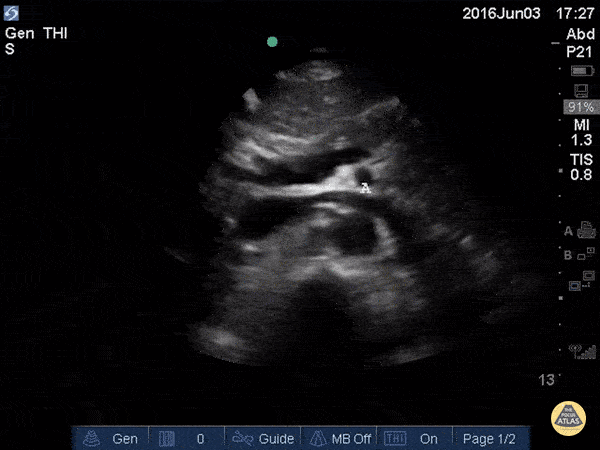
Proximal Aorta Anatomy
In the beginning of this clip we see several major structures in one view. From superficial to deep: liver, pancreas, splenic vein draining into the portal confluence, superior mesenteric artery in transverse (surrounded by a hyperechoic layer of fat creating the “mantle clock sign”), IVC with the left renal vein branching off, and the abdominal aorta. A vertebral body is visible at the bottom of the screen. As the probe is moved caudally, most of these vessels move out of plane and we are left following the course of the IVC and aorta inferiorly.

Seagull Sign
The vertebrae, seen here as the deepest structure as a hyperechoic arch with posterior shadowing (horseshoe sign), is a key anatomic reference when scanning the aorta. The aorta is located immediately anterior to the vertebrae and to the right side on the screen (patient’s left). Contrast this with the inferior vena cava, which is seen to the left of the aorta, often in an oval or teardrop shape. In the center of the screen we see the celiac trunk branching off the proximal abdominal aorta. The Y-shaped “seagull sign” is created by the celiac trunk as it branches into the hepatic artery (left) and splenic artery (right). The portal venous confluence is visible between the IVC and the hepatic artery.
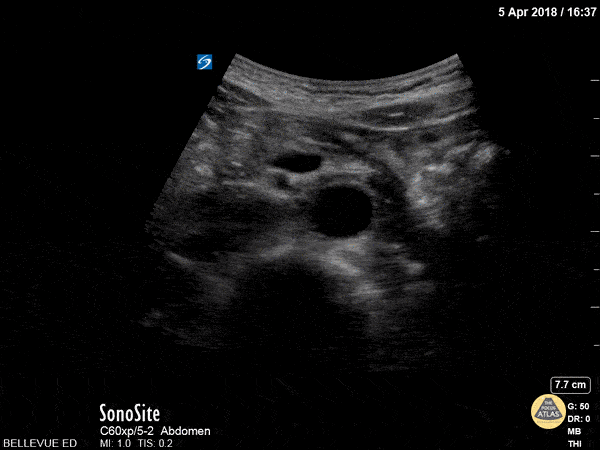
Distal Aorta
In the center of the screen we see the distal aorta in transverse view. As the probe is moved caudally, the aorta bifurcates into the two common iliac arteries. Deep to the aorta we see the round hyperechoic edge of the vertebral body and to the left of the aorta we see the more compressible inferior vena cava.

Dissection Flap in Abdominal Aorta
An elderly male with hypertension and DM presents with C/O chest pain. Bedside ultrasound performed demonstrating a dissection flap in the lumen of the abdominal aorta. A subsequent parasternal long axis show extension into descending thoracic aorta as well.
Image courtesy of Robert Jones DO, FACEP @RJonesSonoEM
Director, Emergency Ultrasound; MetroHealth Medical Center; Professor, Case Western Reserve Medical School, Cleveland, OH
View his original post here.
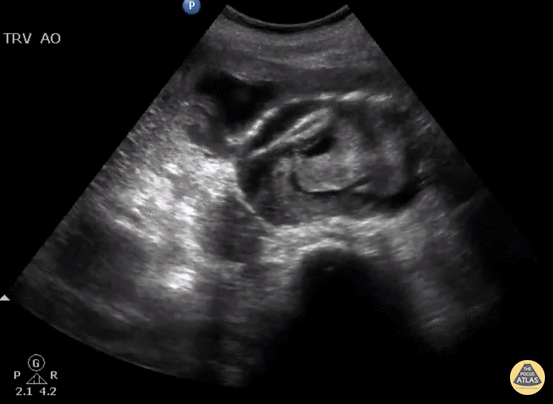
Ruptured AAA with Active Hemorrhage
Elderly female presents to ED with back pain and hypotension. Bedside US shows a ruptured AAA with active hemorrhage in the 9 o’clock position.
Image courtesy of Robert Jones DO, FACEP @RJonesSonoEM
Director, Emergency Ultrasound; MetroHealth Medical Center; Professor, Case Western Reserve Medical School, Cleveland, OH
View his original post here

Incidental AAA
Routine abdominal evaluation using a Sonosite X-Porte curvilinear ultrasound probe revealed this 6.0cm abdominal aortic aneurysm (without rupture or dissection) in a patient with risk factors for the same. This enabled our middle-aged diabetic male with 80 pack/yr smoking history to receive timely evaluation by vascular surgery and subsequent appropriate serial monitoring and follow-up.
Siang-Chean Kua MS-4
Central Michigan University College of Medicine
Additional contributors: Ryan Shelby, MD, Thomas Ferreri, MD, Therese Mead, DO, RDMS, FACEP
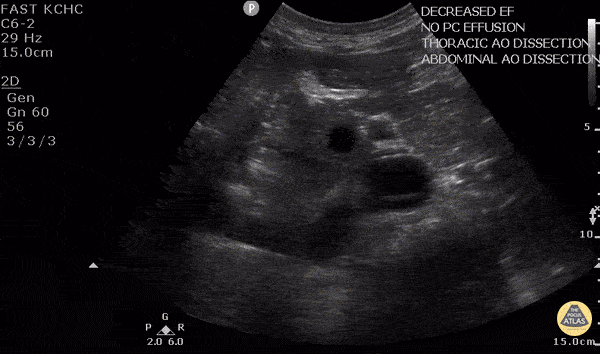
Aortic Dissection
50 y/o M w/ hx of HTN p/w sudden onset upper back pain. POCUS found dissection flap in the descending aorta in both parasternal long view and abdominal aorta. The diagnosis of aortic dissection was quickly confirmed by CT. Given the importance of timely diagnosis with aortic dissection, POCUS allowed rapid and non-invasive diagnosis of a potentially tricky diagnosis, and facilitated expedited treatment and transfer to a cardiothoracic surgery center.
Dr. Robert Allen - Kings County Emergency Medicine
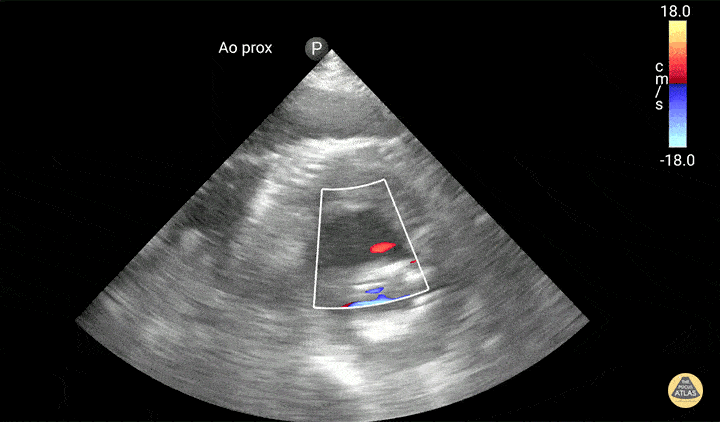
Aortic Graft Endoleak
Active extravasation is seen through endograft into false lumen. Known chronic endoleak, but CT 30 minutes prior to this study showed no active extravasation or impending rupture. Keep an open mind when reassessing your patients, and try not to anchor too much on prior results or others' opinions!
Dr. Jaffa

Mural Thrombus in AAA
74 y/o F hx stage 4 lung cancer, AAA, presented with chest pain and SOB x 1 day. POCUS shows the aorta is larger than the normal diameter of 3 cm, representing an abdominal aortic aneurysm, and measuring approximately 5.6 cm at its largest point. On cross section you are able to see a large mural thrombus with decreased diameter of blood flow through the center.
Juliana Jaramillo MD - Kings County Emergency Medicine
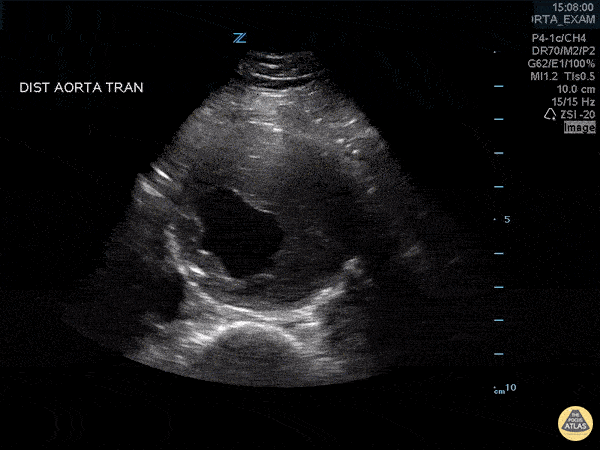
Abdominal Aortic Aneurysm with Thrombus
Approximately 6 cm abdominal aortic aneurysm with intramural thrombus.
Frances Russell, MD, RDMS
Assistant Professor of Emergency Medicine Division Chief, Ultrasound Fellowship Director, Ultrasound

Mural Thrombus in AAA - Doppler
74 y/o F hx stage 4 lung cancer, AAA, presented with chest pain and SOB x 1 day. POCUS shows the aorta is larger than the normal diameter of 3 cm, representing an abdominal aortic aneurysm, and measuring approximately 5.6 cm at its largest point. On cross section you are able to see a large mural thrombus with decreased diameter of blood flow through the center.
Juliana Jaramillo MD - Kings County Emergency Medicine
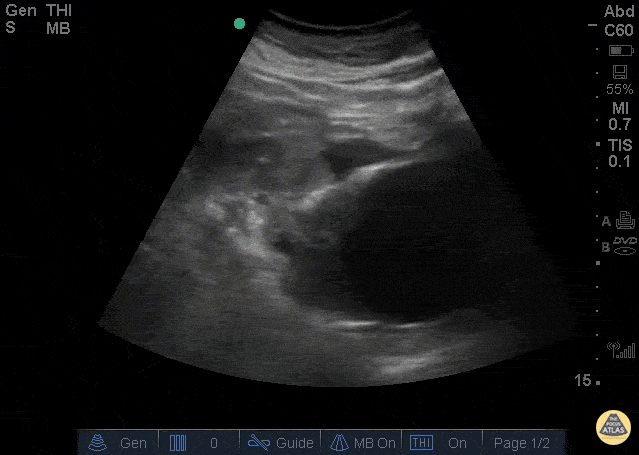
Ruptured AAA
The clip above is from a patient who presented with abdominal pain and syncope. His vitals were notable for tachycardia and hypotension. The image demonstrates a very large abdominal aortic aneurysm with anterior free fluid suggestive of rupture. The patient was taken emergently to the operating room for endograft repair and did well.
Jason Tanguay, DO
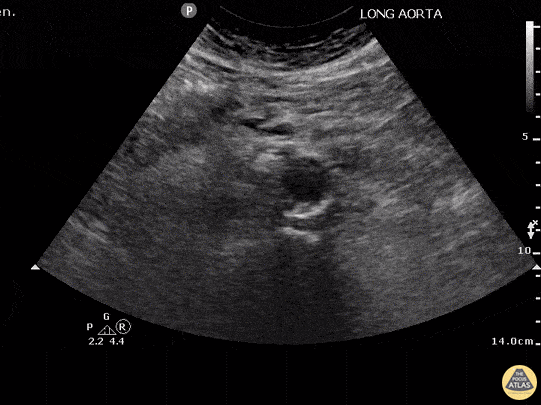
Abdominal Aortic Dissection (Transverse)
Aortic dissection carries an incredibly high mortality that increases 1%/hour. POCUS can be used as a rule-in test to quickly identify this life threatening diagnosis. If a dissection is not seen on POCUS, CT angiography should still be performed because the sensitivity of POCUS is not as high as for other indications.
The spine can be used as a landmark - the echogenic stripe with shadowing in the midline. The aorta is the large vessel anterior and slightly to the right of the spine. In this image an intimal flap can be seen in the anterior third of the aorta consistent with an aortic dissection. The IVC cannot be clearly visualized in this image but would normally be left, less pulsatile, with a less echogenic vessel wall. Non-visualization of the IVC is most often due to bowel gas or compression of the abdomen with the probe.
Justin Bowra MBBS, FACEM, CCPU Emergency Physician, RNSH et al.
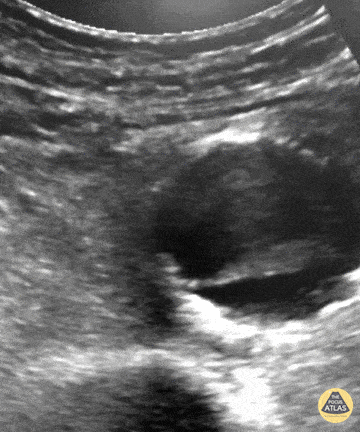
Pulsating Aortic Aneurysm
You may think this a dissection but it's actually an aortic aneurysm filled with thrombus, "with holes" making it a very "happy flappy." CT Confirmed.
Dr. Vincent Rietveld - Amsterdam, The Netherlands

Abdominal Aortic Aneurysm
AAA is defined as a localized balloon-like dilatation of the abdominal aorta greater than 3cm. Risk factors include male sex, increased age, and tobacco use. AAAs should be closely monitored for changes in size. Due to the risk of rupture, elective surgery is recommended when the dilatation is greater than 5-5.5cm, or it is growing in size by greater than 1cm/year. The classic triad of a ruptured AAA include pulsatile abdominal mass, hypotension and pain.
This AAA has an intramural thrombus. Some studies have claimed that POCUS has a ~100% sensitive for increased diameter. 3cm from outer wall to outer wall defines an aneurysm. Slow, graded compression is key to move the bowel out of the way in any abdominal study.
Sukh Singh, MD
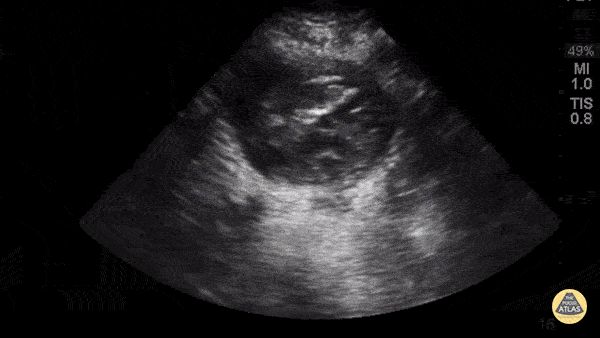
Aorta Posterior Wall Rupture
63yoM witnessed collapsed. Arrived VSA with PEA rhythm. A fast look abdominal aorta POCUS showed a large abdominal aortic aneurysm with internal thrombus and rupture through the posterior wall. Note the AAA is measured from echogenic outer wall to outer wall, not the hypoechoic internal lumen that is seen pulsating. The patient was resuscitated aggressively with blood and initially survived operative repair. Unfortunately he died in the ICU several days later from multiorgan failure.
Dr. Joey Newbigging






















